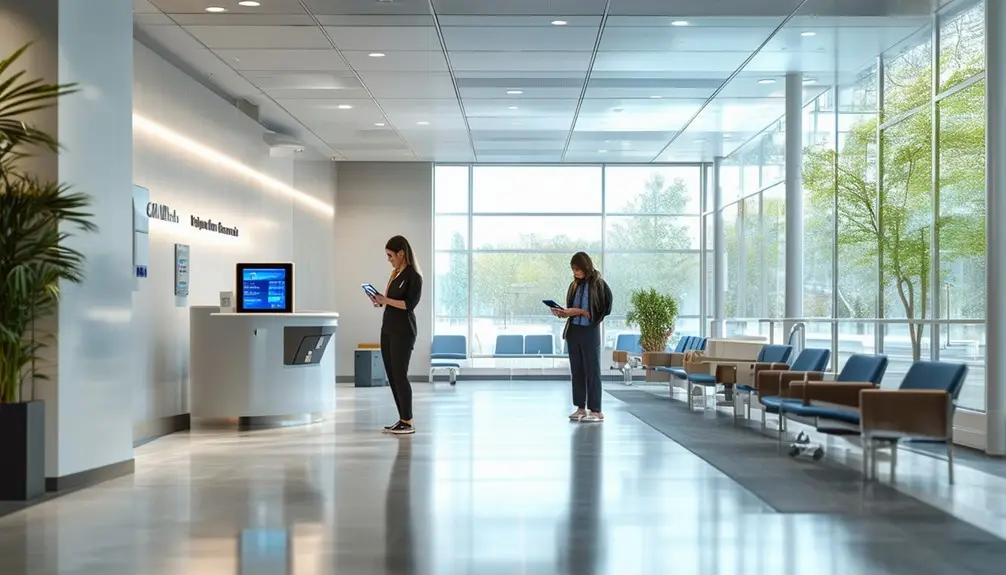To boost efficiency in healthcare visitor registration, employ an advanced management system. Automate check-ins to complete registrations in under 20 seconds. Integrate with your access control and healthcare systems for seamless data synchronization, real-time patient matching, and robust visitor tracking. Tailor your system to offer real-time monitoring and automatic alerts, enhancing both security and compliance. Durable, barcode-enabled badges streamline frequent visits and guarantee proper identification. By adopting these measures, you'll create a streamlined, secure, and visitor-friendly environment. Keep exploring to master fully optimized visitor systems.
Table of Contents
ToggleKey Takeaways
- Automate visitor registration to ensure check-ins last no more than 20 seconds.
- Integrate visitor management software with Electronic Health Records (EHR) for seamless data synchronization.
- Implement access control integration to allow entry for only authorized visitors.
- Utilize real-time patient matching to verify visitor identity and access permissions.
- Employ robust screening protocols, including watch lists and automated alerts, to enhance security.
Importance of Visitor Management
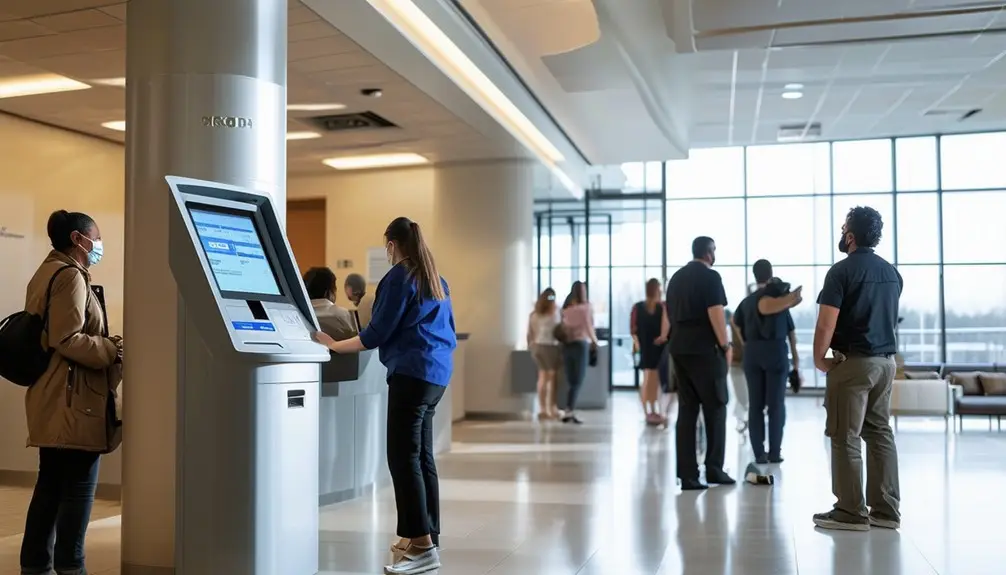
Implementing a strong visitor management system is vital for guaranteeing the safety and security of healthcare facilities. By shifting from outdated paper guest logs to advanced visitor management software, you can effectively monitor and control access to your hospital. This strategic shift enables you to identify authorized visitors while swiftly denying entry to unauthorized individuals, thereby strengthening security.
Visitor management in healthcare is essential, as hospitals often face high foot traffic. Utilizing a system that allows for a quick and non-intrusive check-in process, taking a maximum of 20 seconds, ensures a seamless experience for visitors while maintaining strict security protocols. Integrating visitor management software with access control systems provides thorough visitor tracking and management, necessary for maintaining a secure environment.
Furthermore, the ability to screen unwanted visitors, create watch lists, and set automatic alerts for maximum visitor capacity further enhances your security measures. These features enable healthcare facilities to take proactive steps in safeguarding both patients and staff. Implementing such a system guarantees your hospital remains a safe and secure place, effectively managing the influx of visitors while following strict security standards.
Enhancing System Efficiency
To boost system effectiveness, a strong visitor management solution should streamline entry processes, guaranteeing swift and secure check-ins. Efficient visitor registration is vital in healthcare settings where time and security are paramount. By automating the visitor registration process, you can make sure that the visitor check-in process takes no more than 20 seconds, notably improving operational effectiveness.
Integrating a thorough visitor management system not only replaces outdated paper guest books but also enhances safety for employees and guests. This system can effectively identify authorized visitors and deny access to unauthorized individuals, thereby strengthening security measures. When you integrate visitor registration with access control systems, the entry becomes quick and non-obtrusive, further simplifying entry procedures.
A user-friendly visitor management system enhances the overall visitor experience by making the check-in process smooth and hassle-free. Automating these procedures ensures that critical data is captured accurately and stored securely, eliminating manual errors and reducing administrative burdens. This approach not only improves operational effectiveness but also maintains a high level of security, vital in healthcare environments. By adopting these advanced techniques, you can notably enhance both safety and effectiveness in visitor management.
Integration With Healthcare Systems
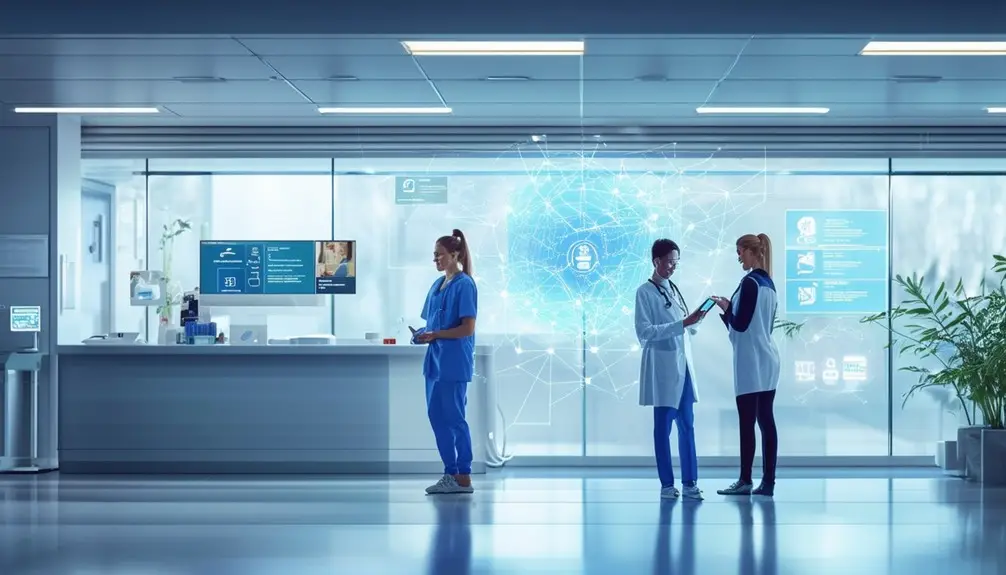
When integrating visitor registration with healthcare systems, you'll achieve seamless data synchronization and real-time patient information matching, ensuring accurate visitor identification. By supporting HL7 interface control, the system integrates effortlessly with hospital management software. Additionally, access control integration enhances security by managing visitor access to sensitive areas, providing a thorough solution.
Seamless Data Synchronization
Seamless data synchronization guarantees that your visitor management system integrates efficiently with healthcare systems like Electronic Health Records (EHR), providing real-time tracking and accurate identification. By leveraging smooth data synchronization, you eliminate manual data entry, which not only reduces errors but also enhances operational efficiency. This integration ensures that your visitor management systems communicate effectively with healthcare systems, streamlining visitor registration processes.
Real-time tracking and accurate identification are critical for maintaining the security and operational flow of healthcare facilities. When healthcare systems integration is executed properly, authorized visitors can gain quick access to patient information, ensuring efficient visitor registration and patient information access.
Here's a quick breakdown of the key benefits:
| Benefit | Description |
|---|---|
| Real-Time Tracking | Monitors visitor movements instantly, enhancing security. |
| Accurate Identification | Ensures only authorized individuals access sensitive areas and information. |
| Data Entry Elimination | Reduces manual input, minimizing errors and saving time. |
| Improved Operational Efficiency | Streamlines processes, allowing staff to focus on patient care. |
| Enhanced Patient Information Access | Authorized visitors can quickly access necessary patient data. |
Incorporating smooth data synchronization into your healthcare facility's visitor management systems leads to a more secure, efficient, and error-free environment, ultimately improving the overall experience for patients and visitors alike.
Access Control Integration
Integrating access control with healthcare systems ensures that only authorized individuals can enter sensitive areas, enhancing security and operational efficiency within your facility. This integration facilitates real-time tracking of visitors, making sure that you know who is in your facility at all times and where they are authorized to go. By linking visitor registration systems directly with healthcare systems, you can create a robust framework that prevents unauthorized access and bolsters overall security.
Access control integration is pivotal for efficient visitor flow management, ensuring smooth access control throughout your facility. When a visitor registers, their information is instantly checked against your healthcare system to verify their authorization status. This process allows for only authorized personnel to access sensitive areas, such as patient wards, laboratories, and data centers. By doing so, you notably reduce the risk of unauthorized access and enhance the overall safety of your healthcare environment.
Moreover, integrating these systems allows for tailored visitor registration processes that adapt to your specific needs. This not only streamlines operations but also contributes to a more secure and efficient healthcare facility. Enhanced security measures, combined with real-time tracking, guarantee your facility remains a safe and well-regulated environment for both patients and staff.
Real-Time Patient Matching
Real-time patient matching in visitor registration systems enhances security by verifying accurate identification and immediate access to patient data. By integrating these systems with healthcare databases, you can seamlessly validate visitor identities against real-time patient records. This not only strengthens security and compliance but also streamlines visitor check-in processes.
Here's how real-time patient matching can benefit your healthcare facility:
- Accurate Identification: Confirms that every visitor is correctly matched to the patient they intend to visit, reducing the risk of unauthorized access.
- Immediate Patient Information Access: Provides instant access to pertinent patient information, allowing for more efficient and informed decision-making.
- Improved Security and Compliance: Bolsters overall security measures and ensures that your facility adheres to stringent compliance standards.
- Enhanced Patient Safety: Minimizes the risk of security breaches, ensuring a safer environment for patients.
Advanced Visitor Screening
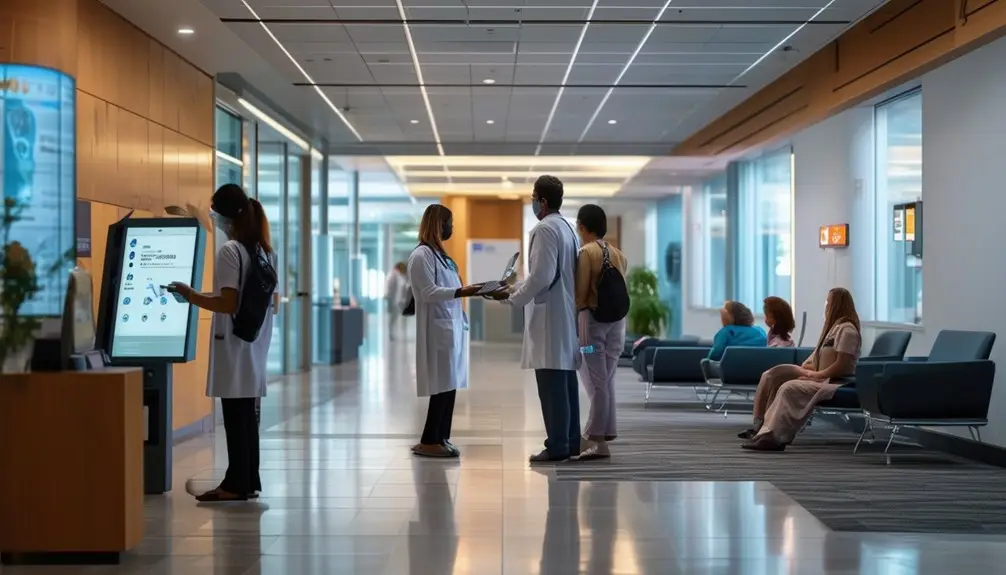
When you implement advanced visitor screening, you establish robust protocols that integrate watch lists like sex offender registries and former employee databases. These systems provide real-time alerts, allowing for immediate action against potential threats. By prioritizing security, you create a safer and more secure environment for patients and staff.
Robust Screening Protocols
Advanced visitor screening protocols frequently leverage extensive watch lists to identify and prevent entry of unwanted individuals into healthcare facilities. By incorporating sex offender lists and former employee databases, you can greatly enhance security measures. Visitor registration systems play a pivotal role in flagging potential threats and preventing unauthorized access. In a healthcare environment, real-time monitoring of visitor movements ensures robust screening protocols, which are essential for reducing security risks and enhancing patient safety.
To implement such protocols effectively, consider the following steps:
- Integration of Watch Lists: Assure your visitor registration systems are configured to cross-reference extensive watch lists, including sex offender lists and former employee databases. This step is crucial for identifying individuals who may pose a risk.
- Real-time Monitoring: Utilize advanced technologies to monitor visitor movements in real-time. This allows for immediate response to any suspicious activity and helps maintain a secure healthcare environment.
- Automated Alerts: Set up your systems to generate automated alerts when potential threats are identified. This ensures prompt action can be taken to mitigate any risks.
- Regular Updates and Audits: Keep your databases and watch lists updated regularly and conduct periodic audits to ensure the integrity and effectiveness of your screening protocols.
Real-time Visitor Alerts
Implementing visitor management programs with real-time alerts is essential for promptly identifying and mitigating potential security threats in healthcare facilities. Advanced visitor screening systems make certain that unwanted visitors are flagged immediately, preventing them from entering the premises. These systems leverage real-time visitor alerts to identify individuals who may pose potential threats, enhancing the overall security of your healthcare environment.
The integration of watch lists is a critical component of these advanced screening systems. By incorporating sex offender databases and former employee lists, you can quickly identify individuals who are not permitted on-site. This integration allows your security team to take immediate action, ensuring that only authorized individuals gain access to sensitive areas within the healthcare facility.
Furthermore, real-time visitor alerts contribute to a safer healthcare environment by providing instant notifications to security personnel. This proactive approach empowers your team to respond swiftly to any security breaches, minimizing risks to patients, staff, and visitors. By employing these advanced visitor screening systems, you enhance the overall security framework of your healthcare facility, guaranteeing a safer, more secure environment for everyone involved.
Customization and Flexibility
Customization in visitor registration empowers healthcare facilities to tailor security protocols precisely to their specific needs and regulatory requirements. By implementing flexible systems, you can customize visitor management protocols to the ever-evolving landscape of healthcare regulations and facility demands. This approach guarantees that your security measures align with the unique challenges your organization faces, enhancing the overall security posture and operational efficiency.
Here's how customization and flexibility can improve your visitor registration system:
- Tailored Security Measures: Personalize security protocols to address the specific needs of different visitor categories. This guarantees efficient identification and access control, reducing the risk of unauthorized access.
- Adaptable Visitor Management Protocols: Flexible systems allow you to adjust security measures quickly in response to new regulations or changing facility requirements, keeping your healthcare facility compliant and secure.
- Enhanced Security Posture: By addressing unique security challenges through personalized visitor policies, you can strengthen the overall security of your organization, safeguarding both patients and staff.
- Optimized Visitor Experience: Customization enables you to streamline the visitor registration process, making it user-friendly while maintaining stringent security standards.
Long-Term Visitor Solutions
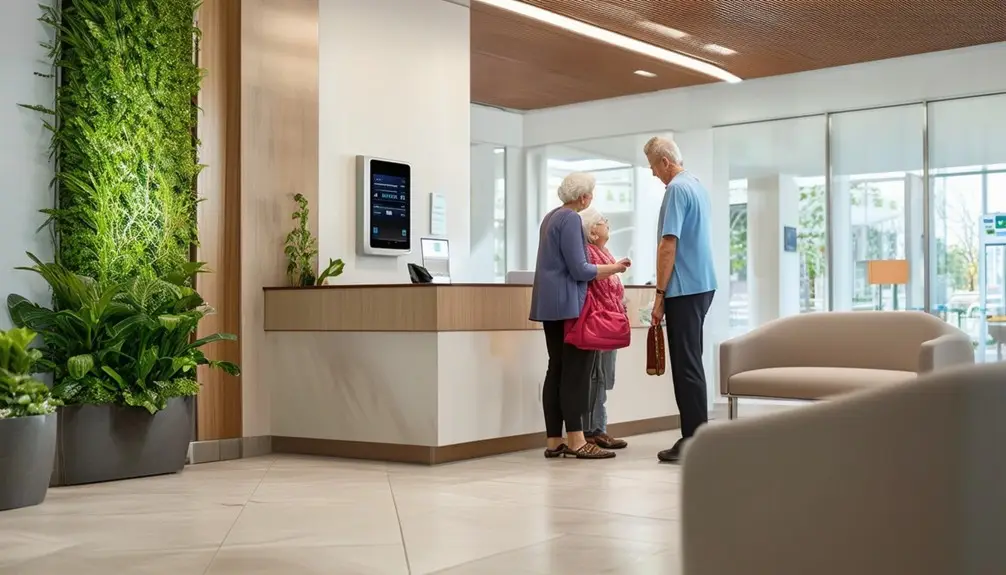
Long-term visitor solutions, such as durable badges with barcodes, streamline frequent check-ins and enhance overall security in healthcare facilities. By issuing long-term visitor badges, you can simplify the sign-in and check-out process for returning visitors, making it both efficient and secure. Durable badges are designed to withstand repeated use, ensuring longevity and reliability.
The integration of barcodes for tracking allows for seamless identification and monitoring of visitors within the facility. This feature not only speeds up the check-in process but also provides improved identification, which is essential for maintaining stringent security measures. Enhanced visitor identification through long-term badges means you can easily manage and monitor access to different areas within the healthcare facility, reducing the risk of unauthorized entry.
Moreover, customized badge styles can be used to differentiate between various visitor categories, aiding in quick recognition and appropriate access control. This segmentation enhances overall visitor management, ensuring that each category of visitor has the appropriate level of access.
Frequently Asked Questions
What Is Visitor Registration System?
A visitor registration system is a digital platform that automates check-ins, captures details like visit purpose, and integrates with access control. It enhances security by scanning IDs and screening visitors against watch lists and databases.
What Is the Purpose of Visitor Register?
Coincidentally, you'll find the purpose of a visitor register vital for maintaining security. It tracks entry and exit times, helps in contact tracing, and supports security investigations, ensuring the safety of everyone in the healthcare facility.
How Do Hospitals Keep Track of Visitors?
Hospitals keep track of visitors by using automated management systems that scan IDs, capture images, and log visit details. These systems integrate with access control, enable real-time tracking, and issue alerts for unwanted visitors.
How Do I Choose a Visitor Management System?
To choose a visitor management system, confirm it integrates with existing hospital software, offers real-time tracking and access control, supports customization, has efficient check-in processes, and complies with healthcare regulations like HIPAA for patient confidentiality.
Conclusion
By embracing efficient visitor registration, you're not just improving workflow but safeguarding critical healthcare environments. Seamlessly integrating with healthcare systems, employing advanced screening, and offering customizable solutions guarantees a robust, adaptable approach. Remember, a secure facility isn't just a goal; it's a necessity. With these strategies, you're not merely managing visitors—you're fortifying the very foundation of patient care and safety. So, take the leap; protect what matters most.
